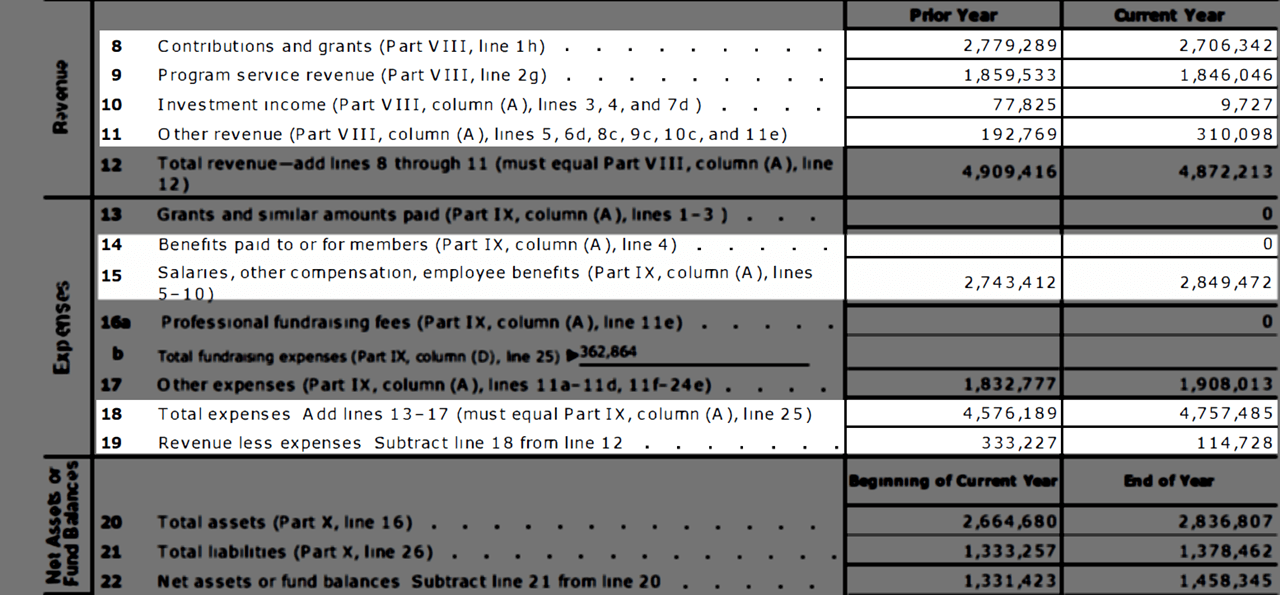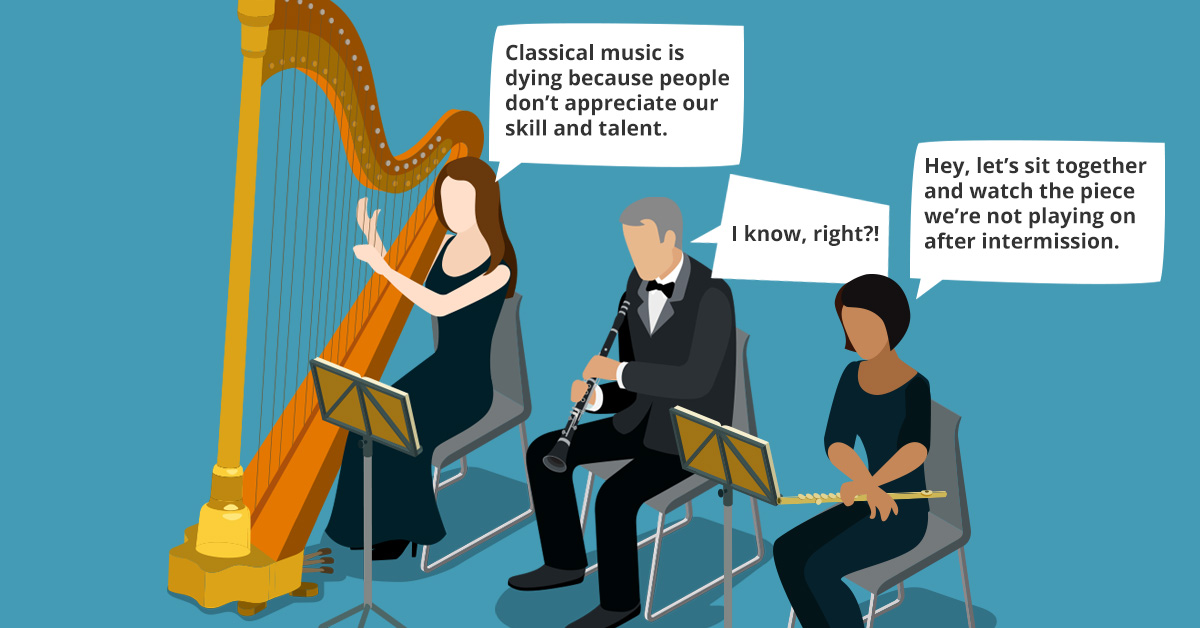It’s no secret that orchestra musician positions are highly competitive, even at ensembles that pay less than living wage. The statistical likelihood of becoming the finalist and receiving a job offer is, at best, dubious. Nonetheless, just because you end up with an offer doesn’t mean you should automatically accept.
 I’ve lost track of how many musicians I’ve worked with over the years who ended up regretting a decision to accept a job offer.
I’ve lost track of how many musicians I’ve worked with over the years who ended up regretting a decision to accept a job offer.
While you can’t expect to become an expert at nonprofit financial analysis after a single article, you can still manage to help dodge a few career bullets with these straightforward skills.
Having said that, let me issue the following disclaimer: this is neither legal nor financial advice. When in doubt, always consult with professional counsel for reliable insight.
Due Diligence Is Fun
Don’t let the concept of research and analysis seem off-putting, at the level we’re going to cover here, it’s not scary. To that end, here’s a good due diligence checklist to get you started:
- Reviewing the organization’s financials.
- Reviewing the collective bargaining agreement and confirming wages/benefits.
- Assessing labor relations and working environment.
- Sizing up your employer.
- Estimating extraction/relocation costs.
To make sure we’re all on the same page, this article is written primarily for musician positions without individual agreements (i.e. overscale contracts). While positions with individual agreements can still benefit from this information, the article is not intended to function as a guide for negotiating individual agreement terms. You can find insight on individual agreements at this article.
Now, let’s take a deeper dive into each of the above points.
Reviewing The Organization’s Financials
At the very least, you need to look at three years’ worth of 990s. You can find links to more than 70 professional orchestra financial disclosure pages at GuideStar.com via Adaptistration’s Orchestra Financial Reports resource.
Any organization not on that list can be tracked down by searching for the institution’s name at GuideStar.com. Keep in mind, some orchestras maintain a mutually exclusive 501(c)3 to oversee endowments so be sure you’re looking at the institutional information and not info for the endowment (they usually have similar names).
Here’s a quick and dirty overview of what to look for:

- Lines 8-11: These provide an overview of where an organization’s money is coming from. More often than not, seeing a 1/3 split for lines eight, nine, and 10 is a good thing. In this example, investment income is very low and that’s an indication you may want to ask about the organization’s endowment and any existing or planned capitalization campaigns. The more lopsided the ratio, the more at risk a group is for massive cutbacks if that revenue stream takes a hit. If line 11 is more than 10% of overall revenue, consider asking about why that’s the case.
- Lines 14 & 15: These show you how much of the budget goes to salaries and benefits. In this example, you see a big ol’ zero for “Benefits Paid to members.” That’s a pretty good sign that the job won’t come with health care or retirement benefits, which is something you can verify in one of the following due diligence steps.
- Lines 18 & 19: This is where you’ll see if the group is running surpluses or deficits. While not a universal rule, if you see a surplus/deficit figure that’s within two percent of the expense figure across all three years, that’s an indication the group may be massaging their numbers. Odds are, they’re rolling over accumulated debt or other expenses and at some point, in time, that’s going to come due. A better indicator for fiscal stability is consistent increases in total expenditures along with surpluses in the five to 10 percent range.
You can also check Part VII to see if any musicians are listed alongside administrators. You’ll find musicians if they earn over $100k per year or if they serve on the board in a voting capacity (check out the 990 from Colorado Symphony as a good example). For orchestras that provide benefits, this will give you a better idea of their actual dollar value. You can find additional salary and benefit figures in Schedule J, Part II.
TIP: If you need to ask someone from the organization any questions, a good point of contact is the Personnel Manager. You should also copy the question to the orchestra committee chair. While it depends entirely on the individual, some are happy to provide a great deal of behind the scenes information while others may be just as tight lipped as managers.
Reviewing The Collective Bargaining Agreement And Confirming Wages/Benefits
Of all the steps musicians tend to overlook, this is the most common. It’s also one of the most damaging to miss. The collective bargaining agreement goes by several colloquial names; it’s often referenced by its initials “the CBA,” and can be called “the master agreement” or simply “the contract.”
While some job openings list annual or per-service wages in the position announcement, that doesn’t mean musicians considering the position should take that as gospel. Instead, opt for a trust but verify approach:
- Ask the employer what the position pays.In most cases, you’ll want to contact the Personnel Manager or other senior manager in the operations department. Keep in mind, for some per-service level orchestras, this is not always a cut and dry answer. For instance, a per-service group that provides no minimum service guarantee won’t be able to provide a firm number so it isn’t as though they are being cagey (although it certainly happens), there really isn’t a clear number. At the same time, they should be able to tell you what average annual pay is like for musicians in the same section where the opening exists.
- Ask the employer for a copy of their CBA.For salaried orchestras, this document will spell out terms related to base weekly wage and number of season weeks. For per-service orchestras, it will provide per-service rates plus any minimum service guarantees for per-service ensembles. You’ll also want to look up info on whether they provide financial items such as travel pay and/or parking reimbursement as these items can have a large impact on actual take-home pay. Don’t be put off by the flood of words inside a typical CBA. Stay sharp and be sure to review everything related to wages and benefits.
- Contact the respective Local AFM (American Federation of Musicians) officeand ask for a copy of the master agreement (in some cases, your respective Local may have to request a copy from the other Local).
- Contact the orchestra’s respective players’ committee.Having said, you should keep in mind that cooperation is not You’ll have to do some Google sleuthing to see if they have a website with contact info. You can also search for a Facebook page or Twitter account.
- Contact ICSOM/ROPA/OCSMfor a copy of the orchestra’s most recent “settlement bulletin,” a document that provides an overview of key items in the most recent master agreement, including compensation info.
- Contact the AFM’s Symphonic Services Department, which exists to “offer advice, assistance and support with all symphony-related questions.” You can ask for access to the current season’s “Wage Scales and Conditions in the Symphony Orchestra” document (available in hard copy, pdf, and online spreadsheet).
To help you on your way, here are online resources for some of the above suggestions. Keep in mind, if you aren’t a member of the AFM, you can pretty much cross off all but the final option, but you won’t know if you don’t ask; just make sure you go in eyes wide open.
- AFM Symphonic Services
- AFM Document Resource Center
- Find an AFM Local Office
- ICSOM Contact
- ROPA Contact
- OCSM Contact
- Seattle Symphony Players’ Organization Contact
TIP: If you don’t already have a user account at the AFM website, go create one. Once you do, you’ll be able to locate some CBAs online via the Symphonic Services Division resource section.
Assessing Labor Relations And Working Environment
This is where your personal and professional connections will pay off (you do take the time to network with colleagues across a variety of age groups, right?).
One of the best resources at your disposal are musicians that recently left the orchestra. That added distance provides a more direct perspective.
Next up are musicians currently working in the orchestra. I’ll take a moment to repeat myself here and point out how important it is to communicate with musicians outside of your own age group and at difference lengths of employment. The more CBA negotiations a musician has experienced, the better.
Remember, you aren’t looking for gossip. You’re attempting to evaluate job satisfaction and day to day happiness on via artistic and non-artistic benchmarks.
Be sure to check Adaptistration’s ensemble archive to see if the orchestra has a history of labor problems and/or work stoppages (strikes and lockouts).
TIP: ensembles with large number of articles have probably had one or more labor disputes over the last two decades.
Similarly, you can check local newspapers for articles about labor relations along with ICSOM and ROPA newsletter archives.
Sizing Up Your Employer
If you find yourself in a position to contact the employer with questions during the above due diligence steps, this should provide an opportunity to size them up as administrators and executives.
My wife, Chattanooga Symphony & Opera concertmaster Holly Mulcahy, has one of the best examples you can find on what this process can reveal via an article she wrote for her blog titled Do You Kiss Your Donors With That Mouth?.
Just days after I won an orchestra position after a grueling audition, a phone call was scheduled for me to speak with the orchestra’s executive director to discuss the new job. Not two minutes into the conversation she told me to hang on and then proceeded to holler the following to someone else in her office:
“Hey! We’re all going over to Hooter’s for some chicken wings…I’ll be there soon, K? And, hey, get me a margarita, but only if the waitress isn’t the bitchy one.”
This was my first impression of the executive director of a symphony whose budget was just short of $20 million.
My initial thought was why didn’t she put me on hold, and then I wondered if she was this casual with donors or patrons. But I didn’t have to think too hard because I already knew the answer.
That’s a good example of a red flag situation.
In the end, you’re an employee. A critical employee, but an employee nonetheless. The people you work for and their conduct will impact your day to day satisfaction. While an unhappy work environment may serve as inspiration to move on, it can also infect your attitude and instill traits you may not be aware of. Before you know it, you’ve become one of the stereotypical bitter musicians that spends more time complaining than practicing.
How much do you think that will help win an audition elsewhere?
Estimating Extraction/Relocation Costs
Congratulations, you just started your first real orchestra job. If this is a per-service ensemble, it won’t take more than a few months for a few realities to settle in:
- You realize that a per-service wage doesn’t cover nearly as many of your bills as you hoped.
- If you’re in a remote location, that means airfare to auditions elsewhere costs 20-30 percent more than if you lived in a metropolitan area. Driving is an option but that takes up more of your time and increases wear and tear on your vehicle.
- Again, if you’re in a remote location, gigging and teaching opportunities are few and far between, which means you may have to get a non-music job to cover expenses. In turn, that non-music job will probably restrict your ability to take auditions on short notice.
After a few years, the reality of your situation comes crashing down around you: your first job is a more of a sentence than the initial rung on your career ladder.
Fortunately, you’ve completed the above due diligence steps, so you have a reliable sense of the income side of your living equation.
Next up, you need to figure out the expenses. Reliable figures for utilities, transportation (auto and airfare), and health care costs are all available online but do yourself a favor and do one thing in person while you’re in town for the audition: visit a local grocery store with your typical shopping list and see how much more/less everything costs.
Lastly, if you play an instrument impacted by changes in temperature, be sure to consider how that new location may increase/decrease annual maintenance costs. If you’re a string musician, be sure to check out countingcosts.adaptistration.com.
Final Thoughts
In the end, finding a position that provides the right balance of economic need and job satisfaction isn’t luck; it’s something you have a great deal of control over.
The more time and effort you put into doing your due diligence, the more likely you’ll reach that point sooner than later.
Keep in mind, one or more red flags on any of the above items isn’t reason to walk away from an offer. Instead, red flags are indicators you use to help determine risk/reward value.
You can find yourself in a place where a dozen flags may fly but identifying them in advance provides a heightened ability to mitigate negative impact that may otherwise hinder your career progress.
At the same time, you may find yourself in a position like Holly Mulcahy and walk away from an offer, and as hindsight later revealed, dodged an other wise career crippling bullet.
The one thing I can promise is if you don’t do your due diligence, expect to pay for it down the road.


